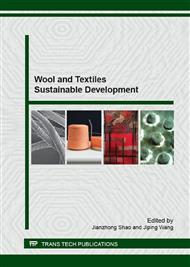p.306
p.317
p.324
p.331
p.338
p.347
p.356
p.363
p.369
Influence of Starch-Degrading Enzyme on Properties of Cotton Fabrics in In Situ Bleaching Process
Abstract:
Enzymes including starch-degrading enzymes and glucose oxidase are used in one-bath process to desize and bleach cotton fabrics. The effect of enzyme concentration on pretreatment efficiency, especially bleaching of cotton fabrics has been investigated by innovatively focusing on glucose conversion ratio of desizing products. The results showed that the starch sizing materials of cotton fabrics were completely removed by starch-degrading enzymes. The conversion ratio of glucose in desized liquor increased with concentration of glucoamylase. Consequently, whiteness of cotton fabrics bleached in one-bath process was also improved, and an increase of 7% in whiteness of bleached fabrics was observed. The fabric tear strength was decreased. However, the loss ratio could be controlled below 15%. The properties of softness and adsorption of bleached cotton fabrics were satisfactory.
Info:
Periodical:
Pages:
338-344
Citation:
Online since:
November 2015
Authors:
Keywords:
Price:
Сopyright:
© 2016 Trans Tech Publications Ltd. All Rights Reserved
Share:
Citation:


